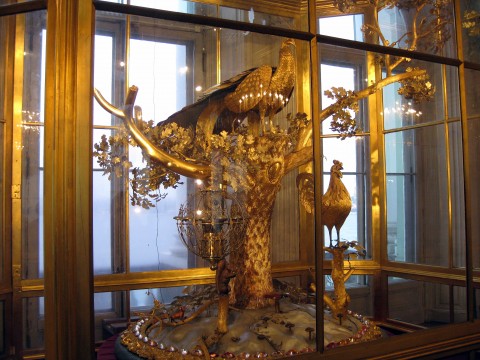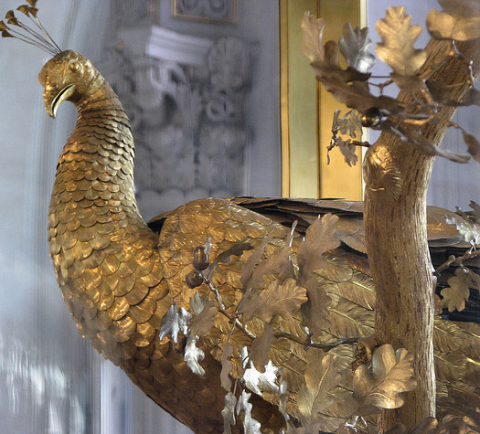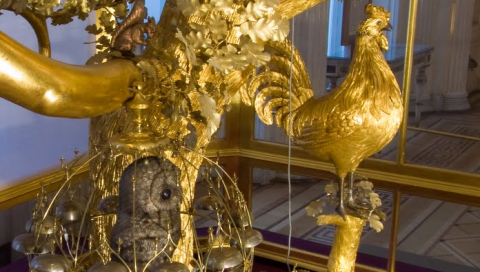Monday, August 13th, 2012
The Peacock Clock, Northern Birds, and Automatons
I’ve been thinking about fantastic clocks during this summer, partly because I recently read some imaginative descriptions of a circus clock in The Night Circus by Erin Morgenstern (which is a really fun novel, by the way). Just the other day, my mother-in-law showed me pictures of her recent trip to the Hermitage, where she got to see the Peacock Clock. This clock was built by the Englishman James Cox, who was commissioned to build the clock by Prince Grigory Potiomkin. Since its commission, this work of art has been intended to be placed within Catherine the Great’s Hermitage.1
This timepiece-automaton is extremely impressive. A peacock, rooster, and owl are depicted on an oak tree. Each of these birds have a lot of symbolism in art history: the owl is associated with night and darkness; the peacock is a symbol of the cosmos, the sun, and resurrection; the rooster is a symbol of light, life, and resurrection. (See more on the symbolism of the clock HERE.)
Each hour, music begins to play on bells that are attached to the owl’s cage. The peacock then spreads its tail, spins around (with tail feathers still spread), and freezes for a moment. Then the peacock returns to its starting position, closes its tail, and lowers its head. After this segment, the rooster begins to crow. (Read more about the clock mechanics HERE.) Although the Hermitage museum only occasionally sets the clock in motion (for the sake of preservation), you can enjoy watching the hourly theatrics in this YouTube clip:
In addition to the birds, the tree is decorated with oak leaves, acorns, and a few squirrels. On the white base, a mushroom acts as a clock dial. A small dragonfly on the mushroom acts as a second hand (see animation HERE). When looking at all of the details on this piece, one would never know that financially-strapped James Cox actually made the Peacock Clock from an existing clock that depicted snakes. (If you look at the bottom of the clock, you can see a snake-like skin serving as the foundation for the composition.)

When I saw an image of this clock among my mother-in-law’s trip photos, I immediately was reminded of Michiel van der Voort the Elder’s pulpit (1713) in the Cathedral of Our Lady in Antwerp (see more information HERE). Like the Peacock Clock, this pulpit is also decorated with different birds (although the Antwerp birds are just sculptures, not automatons). I don’t think that there is a direct connection between these two works of art, but I wonder if there was a fascination with sculpting and depicting large birds during the 18th century. (I’m also reminded of German sculptor Johann Joachim Kändler’s sculpture of a turkey, c. 1733, Getty Museum.) Does anyone know any connections between Northern art and birds in the 18th century?
A final thought: I have a colleague who teaches an art history seminar that revolves around robots and automatons. Although I haven’t had the chance to participate in her course, I know that she explores the idea of why some people perceive robots and automatons and as “creepy.” Do you think that an automaton depicting animals might be perceived as “less creepy” than one which represents a human? I think so – we humans might feel less threatened by a machine that doesn’t assume the appearance of a human (or the suggestion of being truly lifelike). For a basis of comparison, you can watch an 18th century automaton of a female musician on YouTube and form your own opinion.
Do people find this clock to be creepy or intriguing (or both?). Why? I personally don’t think that this clock is creepy at all, perhaps partially because of the animals and music, but also because the bronze, silver and gold colors of the clock aren’t threateningly naturalistic to me.
Do you know of any other great automaton clocks?
1 Catherine the Great (also known as Catherine II) founded the Hermitage in 1764, about a decade before James Cox was commissioned to build the Peacock Clock




That is incredible! I like how it looks like it’s in its own aviary. I definitely think humans don’t find animal automatons as creepy as human ones. Birds might have been preferred because they’re an interesting animal that humans don’t tend to think of as having souls or personalities, like they do with dogs or horses. Maybe there’s some sort of connection with the Enlightenment interest in classification and science too, as with John James Audubon?
You should really read The Invention of Hugo Cabret if you’re interested in automatons. Very interesting!
First, I just discovered your blog and it is incredible!
Second, your post immediately reminded me of a Radiolab podcast on Philip II and his commissioning of an automaton by a clockmaker: http://www.radiolab.org/blogs/radiolab-blog/2011/jun/14/clockwork-miracle/
Hello, olivesandlillies! Thanks for your kind words about my blog. Welcome!
Also, thanks for the Radiolab podcast! The podcast was really interesting. I also liked watching the YouTube video clip that was embedded in the article. I’ve never heard of an automaton being created in conjunction with the healing of a royal family member before. Wow!